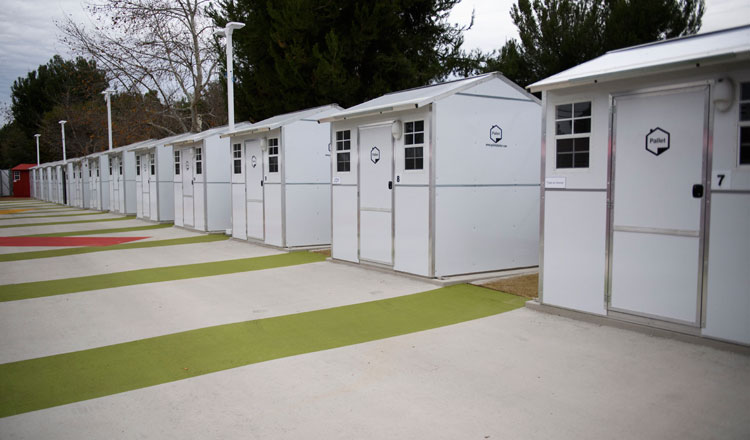HOUSING: LOS ANGELES, Ca. USA- Micro homes built for the homeless of Los Angeles
AFP – In a parking lot in Los Angeles, a village of miniature prefab houses has sprung up, one of several sites in the US second-largest city where so-called “tiny homes” are being put up to help the homeless get back on their feet.
The City of Angels has a large homeless population, second only to New York. Tens of thousands live rough – their tents, and their distress, are plain for any resident or visitor to see.
In the Tarzana neighbourhood, 76 tiny homes paid for by the city have been erected. Each is six square metres and is equipped with two beds and shelving as well as air conditioning and heating.
Each one costs $6,500 and can be set up in just 90 minutes. Toilets and showers are shared and state-of-the-art washing machines face large, bright orange tables under umbrellas. The set-up feels a bit like a campground.
Zuri-Kinshasa Maria Terry, 46, has just moved into the Tarzana development.
The former stripper says she ended up on the streets a year ago, after two weeks in intensive care because she had contracted Covid-19 and waited two months for the tiny home village to open.
“It was the scariest thing in the freaking world to be out there,” Terry said, adding she was “still grasping” the fact that she had found a steady place to live.
In addition to allowing a certain privacy, she said the main advantage of the tiny homes is “safety,” as compared with either living on the street or in a traditional shelter.
The Tarzana site is guarded 24 hours a day and, while residents do not get to keep the keys to their tiny homes, they can lock it from the inside, explains Rowan Vansleve, chief finance and administration officer of Hope of the Valley, a nongovernmental organisation (NGO) that manages the development.
The process begins with “a really hot shower, getting a great meal and then building out a case plan” to help the new resident get out of their precarious situation, according to Vansleve.
“Once you’ve got a case plan, we’re going to assign you a tiny home and you’re going to work that plan however long that takes,” he added.
Residents have access to medical care and therapy. Three meals a day are provided. They are given lodging for three months at a time, which is renewable until the resident finds permanent housing, according to Brandon Hanner, the NGO’s programme manager for the Tarzana site.
The first village of tiny homes in Los Angeles opened in early 2021 and several more followed soon thereafter.
Similar initiatives have sprung up in recent years elsewhere in California, including San Jose, and in Seattle.
For those who advocate for the homeless, the projects are a mixed bag.
Mayer Dahan, founder of the Dream Builders Project, says the tiny homes can be “a very positive transition” for some, but he said he worried about “the concept that solutions could be found by trying to resolve the symptoms, as opposed to the underlying issue”.
For Shayla Myers, a senior attorney at the Legal Aid Foundation of Los Angeles, one problem is that “there is far too little affordable housing for people to exit out of these shelter facilities and into permanent housing”.
While acknowledging that tiny homes are a better option for some, Myers insisted that these homes are in fact “incredibly expensive” because of the operating costs – and that California must do more.
“There is no way to solve the homelessness crisis without addressing the root causes, which are poverty, wealth inequality and a lack of affordable housing options,” she said.
Terry said she is very aware that tiny homes are far from a perfect solution, but for the time being, “it works”.
.












